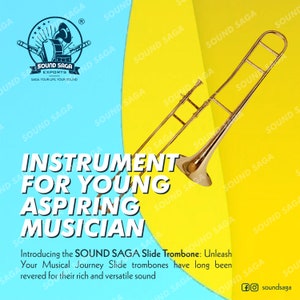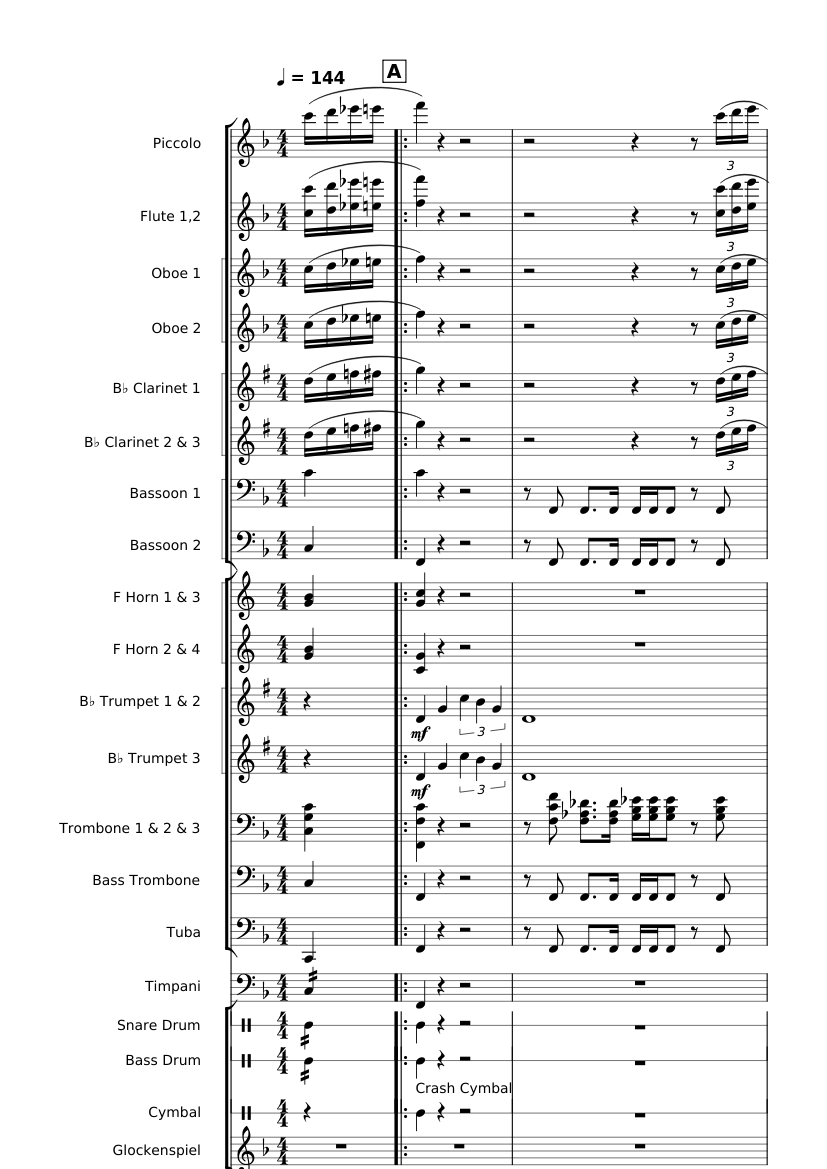Piccolo Trombone: Unleashing the Unique Sound

The piccolo trombone is a small-sized trombone with a higher pitch than the standard trombone. With its compact size and unique sound, it offers a distinct musical experience.
It is commonly used in jazz bands, brass ensembles, and occasionally in orchestras. This instrument is highly versatile, allowing players to perform both solo and ensemble pieces. Its smaller size makes it easier to handle and transport, making it a popular choice for traveling musicians.
Whether you’re a professional musician looking to expand your repertoire or a beginner exploring different instruments, the piccolo trombone offers a unique and exciting musical experience.
History Of The Piccolo Trombone
In the world of brass instruments, the Piccolo Trombone holds a unique place as a smaller yet powerful member. Let’s delve into the fascinating history of this distinctive instrument.
Development And Evolution
The Piccolo Trombone, also known as the Soprano Trombone, evolved from the traditional tenor trombone to offer a higher, more brilliant sound. This evolution allowed musicians to explore a wider range of tones and melodies.
Notable Players
Several notable players have showcased the exceptional capabilities of the Piccolo Trombone. From virtuosic performances to innovative compositions, these musicians have elevated the instrument to new heights.

Credit: www.etsy.com
Design And Features
Piccolo Trombone is a unique musical instrument that captures the attention of both professional musicians and enthusiasts. Its impressive design and standout features are what make it a sought-after choice among trombone players. In this section, we will delve into the size and shape of the Piccolo Trombone, as well as its distinctive sound qualities.
Size And Shape
The Piccolo Trombone stands out with its compact size and distinctive shape. It is smaller than a traditional tenor trombone, making it easier to handle and transport. The compact design also allows players to reach the higher range of tones effortlessly. With its smaller bore diameter and compact bell, it offers a unique playing experience.
Unlike traditional trombones, the Piccolo Trombone features a unique tuning slide arrangement that contributes to its compact size. This design allows for easier maneuverability in various musical settings, including jazz ensembles, brass bands, and chamber music groups.
Distinctive Sound Qualities
One of the key highlights of the Piccolo Trombone is its distinctive sound qualities. Despite its small size, this instrument is capable of producing rich and vibrant tones. The smaller bore diameter provides more control over the sound production, allowing players to achieve a clear and focused tone.
Furthermore, the compact bell design creates a bright and sparkling sound that enhances the overall musical performance. The unique combination of compactness and sound projection makes the Piccolo Trombone a versatile instrument that can adapt to various musical genres and styles.
Whether you are a professional musician looking to expand your range or a student eager to explore new musical horizons, the Piccolo Trombone’s design and distinctive sound qualities make it a remarkable instrument worth considering.
Playing Techniques
Piccolo trombone, also known as the alto trombone, offers a unique and versatile playing experience. Whether used in orchestras, jazz bands, or brass ensembles, mastering its playing techniques is crucial for creating rich, dynamic performances.
Embouchure And Air Support
A proper embouchure is essential for playing the piccolo trombone effectively. The player must form their lips and facial muscles in a way that allows them to control the instrument’s sound production. Strong air support is also crucial for playing in the higher registers and producing a clear, resonant tone. Developing these aspects of technique requires consistent practice and focused attention.
Range And Flexibility
Mastering the range of the piccolo trombone involves developing the ability to play comfortably in both the upper and lower registers. Utilizing proper breath control and embouchure adjustments, players can expand their range and achieve smooth transitions between notes. Additionally, flexibility in playing involves agility and adaptability in executing quick, precise passages, enhancing the expressive capabilities of the instrument.

Credit: musescore.com
Musical Repertoire
Piccolo trombone, also known as the soprano trombone, is a unique and versatile instrument that can be found across a wide range of musical genres. Its compact size and bright tone make it a popular choice for various musical compositions, from classical to jazz to popular music.
Classical Music
In the realm of classical music, the piccolo trombone is often utilized in orchestral settings, chamber ensembles, and solo performances. Its agile and expressive nature allows it to perform a diverse range of classical repertoire, from Baroque to contemporary compositions.
Jazz And Popular Music
When it comes to jazz and popular music, the piccolo trombone adds a distinctive flair to ensembles and bands. Its lively and vibrant sound complements the upbeat rhythms and melodies found in jazz, swing, and popular music genres, making it a sought-after instrument for jazz soloists and ensemble players alike.
Challenges And Rewards
The world of music is a treasure trove of challenges and rewards, and playing the piccolo trombone is no exception. This unique instrument presents a multitude of hurdles that musicians must overcome, but the journey is well worth it. In this blog post, we will explore two specific challenges faced by piccolo trombonists and the rewarding experiences that await those who persevere.
Mastering The Higher Range
One of the most formidable challenges for piccolo trombone players is mastering the higher range of the instrument. Unlike its larger counterparts, the piccolo trombone is designed with a smaller bore size, resulting in a higher pitch. This means that players must develop exceptional control and embouchure strength to hit the higher notes with precision and clarity.
To conquer this challenge, musicians need to dedicate hours of practice to perfecting their technique. Daily exercises that focus on range extension and lip flexibility are crucial. By diligently working on these exercises, piccolo trombonists gradually build up the necessary stamina and muscle memory to effortlessly maneuver through the higher register.
Expressiveness In Performance
In addition to the technical challenges posed by the piccolo trombone, expressing emotion and musicality during performances can also be demanding. The instrument’s smaller size and higher pitch can limit the range of tonal color compared to larger trombones. However, this challenge presents an opportunity for musicians to explore a different level of expressiveness in their playing.
To overcome this obstacle, piccolo trombonists need to focus on employing expressive techniques such as dynamics, vibrato, and phrasing. These techniques allow them to convey emotions and tell captivating musical stories. Through patient practice and experimentation, performers can discover new ways to infuse their music with feeling, captivating audiences with their artistry.
While mastering the challenges of playing the piccolo trombone may require dedication and perseverance, the rewards are boundless. These include the satisfaction of conquering technical obstacles, the delight of producing beautiful sounds in the higher range, and the ability to connect with audiences on a deeply emotional level. So, embrace the challenges, embrace the rewards, and embark on a musical journey like no other with the piccolo trombone!
Piccolo Trombone In Contemporary Music
Exploring how the piccolo trombone is making waves in contemporary music, let’s delve into its innovative applications.
Innovative Compositions
The piccolo trombone’s unique sound is inspiring composers to create new and exciting pieces.
Collaborations With Other Instruments
By collaborating with various instruments, the piccolo trombone brings a fresh dimension to musical arrangements.
Maintenance And Care
Maintaining and caring for your piccolo trombone is crucial to keep it in optimal condition. Regular cleaning and proper storage and transport are key aspects of its maintenance. Here are some effective tips to help you take care of your instrument:
Cleaning And Maintenance Tips
To ensure the longevity of your piccolo trombone, it’s important to clean it regularly. Follow these steps:
- Start by disassembling the instrument carefully and laying each piece on a clean, soft cloth.
- Use a cleaning rod and a soft brush to remove any accumulated dirt or debris inside the slides and tubing.
- Clean the mouthpiece separately using lukewarm water and a mild soap or mouthpiece cleaner. Rinse it thoroughly and dry it with a clean cloth before reassembling.
- Wipe the exterior of the instrument with a clean, lint-free cloth. Avoid using abrasive materials or cleaning agents that could damage the finish.
- Inspect the valves and slides for any signs of wear or damage. Apply valve oil and slide grease as recommended by the manufacturer.
- After cleaning, reassemble the instrument carefully, ensuring that all parts fit together properly.
Storage And Transport
Proper storage and transportation of your piccolo trombone are essential to prevent damage. Here’s how you can store and transport it safely:
- Always store the instrument in its case when not in use. This will protect it from dust, moisture, and accidental bumps.
- Make sure to empty the water keys and remove any moisture from the instrument after each use. This will help prevent the build-up of corrosion and keep the trombone in optimal playing condition.
- When transporting the piccolo trombone, use a sturdy case with proper padding to safeguard it against impacts.
- Avoid exposing the instrument to extreme temperatures or direct sunlight, as this can cause damage to the finish and affect its performance.
By following these cleaning, maintenance, and storage tips, you can ensure that your piccolo trombone stays in great shape and continues to produce beautiful music for years to come.
Conclusion And Outlook
Piccolo trombone has significantly impacted the world of music, showcasing its versatile capabilities and enriching musical compositions. As this instrument continues to evolve, it is essential to consider its continued impact on music and the potential future developments.
Continued Impact On Music
The piccolo trombone has expanded the range and versatility of brass instruments, leading to innovative musical expressions. Performers continue to incorporate its unique sound into various musical genres, enhancing the richness and diversity of compositions.
Future Developments
The future of piccolo trombone holds exciting possibilities, including advancements in materials and design, potentially leading to improved playability and tonal qualities. Additionally, technological enhancements may further enhance the integration of this instrument into modern music production.

Credit: www.amazon.com
Frequently Asked Questions On Piccolo Trombone
What Is A Piccolo Trombone?
A piccolo trombone is a smaller version of a trombone, typically designed for high-pitched music and easy handling. It produces a brighter sound and is often used in classical and marching band music.
How Is A Piccolo Trombone Different From A Regular Trombone?
Piccolo trombones are smaller in size, have a higher pitch, and are designed for more specialized music genres. In contrast, regular trombones are larger, produce a lower sound, and are versatile for various musical styles.
What Are The Benefits Of Playing A Piccolo Trombone?
Playing a piccolo trombone can help improve dexterity and range, especially for high-pitched music. It offers a unique tonal quality, enhances musical versatility, and provides an opportunity for solo performances in certain compositions.
Can A Beginner Learn To Play A Piccolo Trombone?
Yes, beginners can learn to play a piccolo trombone with proper instruction and dedicated practice. Starting with foundational techniques and gradually progressing to advanced skills, learners can master the unique characteristics of the piccolo trombone.
Conclusion
To conclude, the piccolo trombone is a remarkable instrument known for its unique sound and versatility. With its compact size and high pitch capabilities, it offers a distinct musical experience for both professional musicians and aspiring trombonists. Whether you’re playing in a jazz band, marching band, or chamber ensemble, the piccolo trombone’s range and agility make it a valuable addition to any musical repertoire.
Embrace this extraordinary instrument and let its vibrant melodies captivate your audience.




